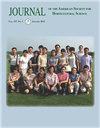西伯利亚杏果实和籽粒发育中NAC转录因子家族基因的全基因组鉴定和表达分析
IF 1.1
4区 农林科学
Q3 HORTICULTURE
Journal of the American Society for Horticultural Science
Pub Date : 2021-06-02
DOI:10.21273/JASHS05007-20
引用次数: 3
摘要
NAC (NAM, ATAF1/2和CUC2)家族是一组植物特异性转录因子,在植物生长发育,特别是果实和果核发育中起着重要作用。本研究旨在鉴定西伯利亚杏NAC基因(PsNACs)家族成员并探讨其功能。将102个PsNAC预测蛋白(PsNACs)划分为14个支系,并定位到8条染色体上。同一支系的PsNACs具有相似的结构。结果表明,这些PsNACs基因与日本杏NAC基因关系密切。PsNACs的表达模式分析显示,在不同组织和果实和籽粒发育的不同阶段存在许多差异。这8种PsNACs在果实和果仁发育中都起着至关重要的作用。在进化枝I、III、VI、VII和XIII中,有7个PsNACs (PsNACs 18、64、23、33、9、4和50)与果实发育有关。8种PsNACs (PsNACs 6、13、46、51、41、67、37和59)在进化枝I、II、V、VIII和XIII中参与果实成熟。4种PsNACs (PsNACs 50、4、67和84)在进化枝I、III、V和XIII中影响核的硬化。在本研究中,我们对西伯利亚杏NAC基因进行了鉴定。本研究结果将为进一步研究PsNACs在西伯利亚杏果实和果仁发育中的生物学作用提供资源。本文章由计算机程序翻译,如有差异,请以英文原文为准。
Genome-wide Identification and Expression Analysis of NAC Transcription Factor Family Genes during Fruit and Kernel Development in Siberian Apricot
The NAC (NAM, ATAF1/2, and CUC2) family is a group of plant-specific transcription factors that have vital roles in the growth and development of plants, and especially in fruit and kernel development. This study aimed to identify members of the NAC gene (PsNACs) family and investigate their functions in siberian apricot (Prunus sibirica). A total of 102 predicted PsNAC proteins (PsNACs) were divided into 14 clades and the genes were mapped to the eight chromosomes in siberian apricot. The PsNACs of the same clade had similar structures. A synteny analysis showed that the PsNACs had close relationships with the NAC genes of japanese apricot (Prunus mume). An expression pattern analysis of the PsNACs revealed many differences in various tissues and at different stages of fruit and kernel development. All eight PsNACs in clade XI have crucial roles in fruit and kernel development. Seven PsNACs (PsNACs 18, 64, 23, 33, 9, 4, and 50) in clades I, III, VI, VII, and XIII are related to fruit development. Eight PsNACs (PsNACs 6, 13, 46, 51, 41, 67, 37, and 59) in clades I, II, V, VIII, and XIII are involved in fruit ripening. Five PsNACs (PsNACs 6, 94, 41, 32, and 17) in clades I, IV, V, VII, and XI regulated the rapid growth of the kernel. Four PsNACs (PsNACs 50, 4, 67, and 84) in clades I, III, V, and XIII affected the hardening of the kernel. Four PsNACs (PsNACs 17, 82, 13, and 51) in clades II, XI, and IX acted on kernel maturation. We have characterized the NAC genes in siberian apricot during this study. Our results will provide resources for future research of the biological roles of PsNACs in fruit and kernel development in siberian apricot.
求助全文
通过发布文献求助,成功后即可免费获取论文全文。
去求助
来源期刊
CiteScore
3.80
自引率
0.00%
发文量
31
审稿时长
2 months
期刊介绍:
The Journal of the American Society for Horticultural Science publishes papers on the results of original research on horticultural plants and their products or directly related research areas. Its prime function is to communicate mission-oriented, fundamental research to other researchers.
The journal includes detailed reports of original research results on various aspects of horticultural science and directly related subjects such as:
- Biotechnology
- Developmental Physiology
- Environmental Stress Physiology
- Genetics and Breeding
- Photosynthesis, Sources-Sink Physiology
- Postharvest Biology
- Seed Physiology
- Postharvest Biology
- Seed Physiology
- Soil-Plant-Water Relationships
- Statistics

 求助内容:
求助内容: 应助结果提醒方式:
应助结果提醒方式:


